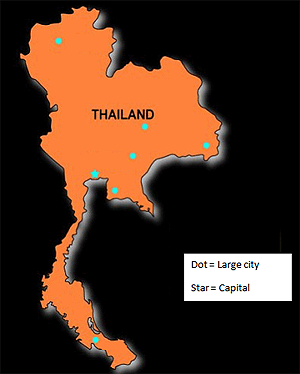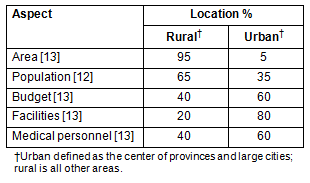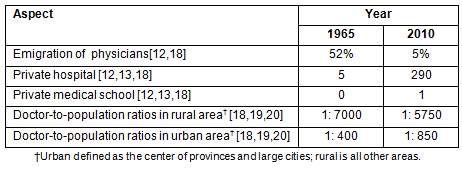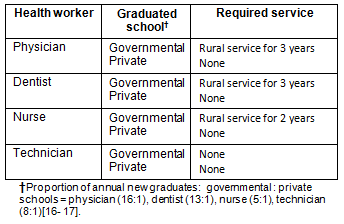Context
The UN's Alma-Ata Declaration of health care for all, regardless of their geographic location requires an effective allocation of physicians and health workers among the entire population of each country1. However, a maldistribution of healthcare workers is apparent worldwide1,2 with, for example 24% of all physicians working in rural areas where approximately 50% of the world's population lives2. Action has been called for to remedy this widely recognized problem3,4.
Attempts to find solutions have varied according the country. For example, Japan has implemented financial incentive programs based in medical schools5,6. In Ethiopia, rural physicians are given financial incentives under a graded rural salary system7. In Australia and Canada, medical school campuses are built in rural areas in order to expose students to the rural environment8. Using compulsory rural service requirements for physicians generally, or certain types of physicians, may be the most reliable way to deploy the health workforce to underserved areas where physicians are unlikely to practice voluntarily7, and this is the case in many countries7.
In Thailand, a system of mandatory rural health has been long established as the key to expanding the primary healthcare workforce in rural areas (Fig1), and to improve the overall public health status of the country9.

Figure 1: Map of Thailand, which contains 76 provinces and 7 large cities, including the capital. Orange areas are rural, which in Thailand are any area other than the center of provinces and major cities.
Medical system in Thailand: A long history of modern medicine and mandatory rural health service
In 1896, Siriraj Hospital, the first modern hospital in Thailand was established in Bangkok10. Four years later, the opening of the first Thai medical school marked the origin of medical education in Thailand10. From the beginning, a unique public service system assured that all graduates worked as governmental physicians to provide modern medical care at government public health offices throughout Thailand10,11. This mandatory public work was regarded as in-return service for government tuition support of medical students12. A penalty system for graduates who violated a mandatory rural work contact increased compliance, with an original penalty of US$4,800 which increased to $8,000 in 1971, $16,000 in 1973, and then reduced to $10,000 in 1998. However, new graduates have had an option to repay the governmental 'loan' after graduation12. A health system summary is provided (Table 1).
Table 1: Aspects of rural and urban health in Thailand12,13

Following the first hospital and medical school, there was great progress in the medical and public health system in Thailand. Seven years after the first medical school, the first nursing school was opened10 and a similar mandatory health service system was also applied to graduate nurses. Since then, the number of medical, nursing and paramedical schools has increased14. From its 19th Century origin, the mandatory public service of health professionals or 'internship', is deeply embedded in the Thai medical tradition15,16.
Responding to an emerging shortage of physicians in rural areas, in 1968 the Thai government set high medical education fees for public medical schools and launched a program of mandatory rural service in which all newly graduated physicians worked for public medical facilities for 3 years in exchange for waiver of the fee. This was different from the pre-1968 system where the mandatory service could be either rural or non-rural. In addition, a special add-on (triple) salary was provided for physicians who practiced in very remote rural area12. This had the dual aims of stemming the emigration of Thai doctors to foreign countries and providing a solution to the inequitable distribution of physicians within Thailand17.
At present several private medical and nursing schools exist and mandatory rural service does not applicable to these private graduates. Summaries of Thai health worker distribution in the two eras (Table 2), and the present mandatory rural healthcare service are provided (Table 3).
Table 2: Situation of rural health services before and after the implementation of implementation of mandatory service in 196812,13,18-20

Table 3: Present (2010) mandatory rural service for health care workers in Thailand16,17

Physician shortage in Thailand due to globalization
The implementation of the mandatory service system improved the shortage of physicians in rural areas and the physician to population ratio in rural areas increased dramatically (Table 2). Current (2010) ratios for physicians and nurses are 1:5750 and 1:532, respectively (in urban areas 1:850 and 1:329)18. Despite this improvement, a shortage of physicians and other health personnel has became increasingly apparent during the rapid growth of Thai economy in the 1990s12,21. A substantial number of new private hospitals (3.3-fold increase in 10 years12 with an increase from 1000 in 1985 to 3300 in 199512) has drained physicians from the mandatory rural service system which was exclusively for the public sector21, with a net loss of doctors from public to private increasing from 8% in 1994 to 30% in 199712. Although this slowed in the economic crisis of the late 1990s when hundreds of private hospitals were closed or downgraded to clinics, the issue has returned with economic growth22. Approximately 200 newly graduated physicians (12% of total new graduates) violate the mandatory service contact annually18.
Several factors are responsible for draining young physicians from rural service to the private urban hospitals. The main factor is the significantly higher salaries in the private sector12,23. Despite signing a rural service contract on admission to public medical and nursing school and serious penalties (fined up to US$10,000 in case of physicians) for its violation, a substantial number of graduate physicians and nurses do not commit to mandatory rural practice. The approximately 10-fold higher salaries in urban private hospitals, and the fact that many private hospitals will pay the physician and nurse penalty charges24 are responsible for this.
Lessons learned
To support mandatory rural service, Thailand has recently introduced some new strategies to improve rural health care. These include the '30 Baht' policy; the Medical Education for Students in Rural Area Project (MESRAP); rural service as a prerequisite for specialist training; and the establishment of a new rural medical school.
The '30 Baht' policy
A national universal health coverage system known as the '30 Baht' policy25,26 was implemented in 200117. This low-fee system supports the health access of those otherwise unable to access healthcare facilities, predominantly the rural population25,26.
Following the introduction of this policy, financial management became increasingly important and time-consuming for administrators at rural medical facilities, who were often newly graduated physicians undergoing mandatory rural service. Not only it this a new challenge for recently graduated physicians27, but also it is often a task beyond the ability of these young and inexperienced administrators, with a recent report showing government funding being channeled more into curative services than community facilities28.
However, the 30 Baht policy has led to a more equitable and efficient health system28. This is not without its own problems, for increased access to healthcare facilities has led to an expansion of medical need in rural areas. With double the number of daily out-patients than previously29, this has created a situation of over-work and dissatisfaction among rural physicians. In addition, there has been an exacerbation of rural-urban tension29, with rural dwellers contributing a lower amount (collected as tax) to the health system, while deriving greater benefit from the policy.
Medical Education for Students in Rural Area Project
The MESRAP has been in operation for many years in a collaboration between medical schools and the Thai Ministry of Public Health in order to increase the number of physicians in specific rural areas30,31. The project was trialed first on a small scale at a medical school in 1974, and then expanded to other schools in 1980s. Following this, in 1985 the MESRAP was expanded into a new program, the Collaborative Project to Increase Production of Rural Doctors (CPIRD) using the regional tertiary hospitals of Thai Ministry of Public Health as training centers for clinical-year medical education. This has been widely implemented in every governmental medical school since 199730-32 and recruits students from rural and remote areas. While physicians newly graduated from this program are generally positive about mandatory rural service33, their examination scores are reportedly as lower than non-MESRAP medical students34. In addition, the MESRAP students are reported to be less motivated regarding rural medicine studies35.
The program has effectively increased the number of MESRAP physicians from approximately 500 in 1974 to approximately 1700 per year at present (2010)12. Of all the entrants to medical schools in Thailand, the proportion of rural medical students has significantly increased from 23% in 1994 to 31.5% in 200112 and this was due to the expansion of MESRAP. Almost all graduated physicians from this new group went to rural locations after graduation32, with the retention rate after mandatory service reported to be two-thirds12.
Rural service as a prerequisite for specialist training and obtaining a postgraduate scholarship
The aims of the rural service as a prerequisite for specialist training and postgraduate scholarship policy were to widen the range of physicians involved in mandatory rural service while stemming the draining of physicians from public to private sectors. At least one year of rural practice is required for all the medical graduates (from public and private schools) to enter specialty training. A report from the rural provincial public health administrators who supervise the mandatory rural service physicians is also a required document for the specialty training selection process36.
A specific scholarship has also been provided by the Royal Thai Government for those public school graduates who complete their mandatory rural service. Those who complete 3 years of rural service may apply for the scholarship which covers the total specialty training fee (approximately US$12,000) which must be paid by those in training (although there is a monthly salary of approximately $260, regardless).
This new system has been implemented for approximately 10 years and it appears to be an effective tool to force all newly graduated physicians to work in the rural hospitals for at least 1 year. Although the total period for mandatory service for public school graduates is 3 years, the prerequisite for a resident (specialty) training application is only 1 year due to serious shortages in some specialist fields. However, as well as mandatory rural service for public school graduates, not all physicians are willing to serve in rural areas. As a system that allows less experienced physicians to serve it is controversial, and there are fears that it may compromise the local population's confidence in the healthcare service.
New salary rate for the physicians
The special salary rate37 for rural physicians is another main financial tool to attract Thai physicians to work in rural areas12. Adding to the baseline salary (approximately US$350), there is also a monthly 'top up' amount ($400) for rural physicians who practice only in governmental units12. The salary of new rural physicians is reportedly an important factor in long-term retention38, for in a situation of high workload but low salary there is a high attrition rate39. The Thai government announced a 5% further increase to take effect in early 2011; however, the increased salary is still not as much as can be earned in a private hospital. .
The establishment of a new rural medical school
The establishment of regional medical schools can be an effective way to promote an equitable distribution of physicians12, and this is not a new concept among the Thai medical establishment40. While in the past, new medical schools have been in urban areas12; recently new rural medical schools have been founded with the aim of recruiting and educating students from the local (rural) areas. The newest of these is in Naratiwat Province in the Southern Region (2006). The main aim of this medical school is to enroll local students and encourage them to serve the population of the 3 southern-most provinces of Thailand that suffer from terrorist activity and a serious lack of rural physicians. This new medical school was founded according to a governmental policy aimed at 'improved education for fighting the terrorism problem'41.
The success of mandatory rural service
In spite of its long history, the success of the Thai mandatory rural health service system is not well known outside Thailand. It has largely solved the problem of an inadequate number of physicians and other healthcare workers in rural areas. In addition, the new policy that allocates all newly graduated physicians to rural areas for a year as a prerequisite to entry to specialist training appears equally successful. Physicians graduated from private medical schools and those from foreign schools are increasingly working in rural areas. While rural work may be a difficult experience for some of the physicians, under the progressive Thai schemes it is also seem as and opportunity to gain a broad range of medical experience.
Problems associated with the present mandatory service
Mandatory rural service is not without its own problems. The workers obtained under this system are newly graduated and less experienced. Forcing young workers into rural work can (and probably does) demoralize them. There is still controversy about whether mandatory service is ethically acceptable.
How to retain health workers after their mandatory rural service is also an unsolved issue. Some advantages are offered to physicians who continue to work for more than 5 years in rural hospitals. These physicians may take examinations for some board certifications (such as family medicine and preventive medicine). The Thai Civil Service Commission recognizes these certificates as equivalent to a degree at PhD level, and this ensures an increase in baseline salary12. However, certifications such as family medicine and preventive medicine are not popular among general Thai physicians12.
Oother factors, such as an increasing awareness of quality of care and patients' rights, potentially make newly graduated medical doctors cautious about working in rural areas with no guidance from those senior (usually the case in Thai mandatory rural service). These limiting factors must be taken seriously because they may threaten the effectiveness and subsequently the life of this system. Support from the Thai government to maintain a positive regard and motivation for the rural physician role is essential12.
Conclusion
In conclusion, the Thai mandatory rural health service has succeeded in ameliorating the shortage of rural health workers, although it has its own limitations and problems. In order to maintain its effectiveness, the system requires continuous amendments in response to changes in the medical and economic landscape of Thailand.
References
1. International Conference on Primary Health Care. Declaration of Alma-Ata. (Online) 1978. Available: http://www.who.int/hpr/NPH/docs/declaration_almaata.pdf (Accessed 15 April 2009).
2. Zarocostas J. WHO issues guidelines on retaining health workers in rural areas. British Medical Journal 2010; 341: c3774.
3. WONCA Working Party on Rural Practice. Health for all Rural People: The Durban Declaration. (Online) 1997. Available: http://www.globalfamilydoctor.com/aboutWonca/working_groups/rural_training/durban_declaration.htm (Accessed 31 July 2009).
4. World Health Organization. Increasing access to health workers in remote and rural areas through improved retention. (Online) 2009. Available : http://www.who.int/hrh/events/2009/expert_meeting/en/index.html (Accessed 15 November 2010).
5. Inoue K, Hirayama Y, Igarashi M. A medical school for rural areas. Medical Education 1997; 31: 430-434.
6. Matsumoto M, Inoue K, Kajii E, Takeuchi K. Retention of physicians in rural Japan: concerted efforts of the government, prefectures, municipalities and medical schools. Rural and Remote Health 10: 1432. (Online) 2010. Available: http://www.rrh.org.au (Accessed 10 February 2011).
7. Frehywot S, Fitzhugh Mullan F, Paynea PW, Rossa H. Compulsory service programmes for recruiting health workers in remote and rural areas: do they work? Bulletin of the World Health Organization 2010; 88: 364-370.
8. Strasser R, Neusy AJ. Context counts: training health workers in and for rural and remote areas. Bulletin of the World Health Organization 2010; 88: 777-782
9. Rohde J, Cousens S, Chopra M, Tangcharoensathien V, Black R, Bhutta ZA et al. 30 years after Alma-Ata: has primary health care worked in countries? Lancet 2008; 372: 950-961.
10. Suwanik R. Eighty-fourth anniversary of Siriraj. Siriraj Hospital Gazzett 1976; 28: 1115-1121.
11. Poungvarin N. Special Lecture on the Celebration of the Thirty Anniversary of Mahidol University Entitled "The University Role in the Leading of Community". Siriraj Hospital Gazzett 1999; 51: 214-216.
12. Wibulpolprasert S, Pengpaibon P. Integrated strategies to tackle the inequitable distribution of doctors in Thailand: four decades of experience. Human Resources for Health 2003; 1: 12.
13. Wiwanitkit V (Ed). Principles of rural study in health aspect for students studying multidisciplinary subject. Bangkok: Chulalongkorn University, 2008.
14. Charuluxananan S, Chentanez V. History of King Chulalongkorn Memorial Hospital: 90 years anniversary. Journal of Medical Association of Thailand 2004; 87(Suppl 2): xii-xvi.
15. Vachananda B. Our internship. Siriraj Hospital Gazzett 1993; 45: 736-738.
16. Viriyavejchakul A. Intern-extern. Thai Medical Council Bulletin 1984; 13: 199-201.
17. Sakunphanit T. Universal health care coverage through pluralistic approaches: experience from Thailand. (Online) 2006. Available: http://www.nhso.go.th/eng/content/uploads/files/research_pub_04.pdf (Accessed 1 September 2010).
18. Office of the Civil Service Commission. Office of the Civil Service Commission Revealed that Ratio of Physician - Nurse to Thai Population is Insufficient but not Seriously Inadequate. (Online) 2010. Available: http://news.impaqmsn.com/articles.aspx?id=273945&ch=gn1 (Accessed 31 July 2010).
19. Thai National Economic and Social Development Board. Thai National Economic and Social Development Plan No 2. (Online) 2010. Available: www.nesdb.go.th/Portals/0/news/plan/p2/M1.doc (Accessed 15 November 2010).
20. Health Insurance Department. Universal Coverage and Decrease in Quality of Medical Treatment. (Online) 2010. Available: http://hinso.pbro.moph.go.th/Mambo/index.php?option=com_content&task=view&id=149&Itemid=1 (Accessed 15 November 2010).
21. Srivanichakorn S, Nittayarampong S, Kittidilokkul S, Laohaboripat S. Brain drainage, situation and solution. Thai Medical Council Bulletin 1991; 20: 354-371.
22. Wibulpolprasert S, Pachanee CA, Pitayarangsarit S, Hempisut P. International service trade and its implications for human resources for health: a case study of Thailand. Human Resources for Health 2004; 2: 10.
23. Temchawara P. Factors affecting attitude of medical students towards rural work. Thai Medical Council Bulletin 1985; 14: 575-576.
24. Lertruksana V. Money and private hospital. Thai Medical Council Bulletin 1980; 9: 387-388.
25. Suebvonglee S. Policy "30 baht" for treatment of all diseases. Buddhachinaraj Medical Journal 2001; 18: 73.
26. Treerutkuarkul A. Thailand: health care for all, at a price. Bulletin of the World Health Organization 2010; 88: 84-85.
27. Hughes D, Leethongdee S, Osiri S. Using economic levers to change behaviour: the case of Thailand's universal coverage health care reforms. Social Science Medicine 2010; 70: 447-454.
28. Prakongsai P, Limwattananon S, Tangcharoensathien V. The equity impact of the universal coverage policy: lessons from Thailand. Advances in Health Economics and Health Services Research2009; 21: 57-81.
29. Laisnitsarekul B. Toward equity in education: academic performances of medical students in regular, MESRAP and problem-based programs. Chulalongkorn Medical Journal 2003; 47: 551-565.
30. Thoresen SH, Fielding A. Universal health care in Thailand: concerns among the health care workforce. Health Policy 2010; 99(1): 17-22.
31. Tantraporn W. The need of MESRAP graduate for continuing education. Ramathibodi Medical Journal 1992; 15: 117-120.
32. DocChula Forum. Rural physician and medical degree. (Online) 2010. Available: http://forum.docchula.com/index.php?topic=9438.5;wap2 (Accessed 15 November 2010).
33. Hongladarom T, Varavithya C, Ruamsuke S, Makinanukul S, Sangprasert B. Assessment of the medical education for students in rural area project (MESRAP) graduates (a comparative study). Journal of Medical Association of Thailand 1989; 72(Suppl1): 5-10.
34. Pholwan N, Tantayaporn K. The comparative study of sixth year medical students' achievement among conventional curriculum, MESRAP curriculum, and problem-base, Faculty of Medicine, Chulalongkorn University in academic year 1995. Chulalongkorn Medical Journal 1996; 40: 713-724.
35. Sooksangchaya S. The study of community medicine and the attitude of the medical students in MESRAP program. Journal of Prapokklao Hospital Clinical Medical Education Center 1985; 2: 1-3.
36. Khongphatthanayothin A, Chongsrisawat V, Wananukul S, Sanpavat S. Resident recruitment: what are good predictors for performance during pediatric residency training? Journal of Medical Association of Thailand 2002; 85 Suppl 1: S302-S311.
37. Kapook Forum. Thai Govenment Increased Govenmental Officer Salary. (Online) 2010. Available: http://hilight.kapook.com/view/23893 (Accessed 15 November 2010).
38. Archanuparp S. The next step for the rural physician. Clinic 2004; 20: 617-619.
39. Wongvatcharapaiboon P. Sanction by resigning, a solution for physician shortage? Clinic 2008; 24: 755-758.
40. Thesuporn P. Production of physician and distribution to the rural. Thai Medical Council Bulletin 1982; 11: 27-29.
41. Wikipedia. Faculty of Medicine, Narathiwasrajanakarin University. (Online) 2010. Available: http://th.wikipedia.org/wiki/ (Accessed 21 November 2010).
